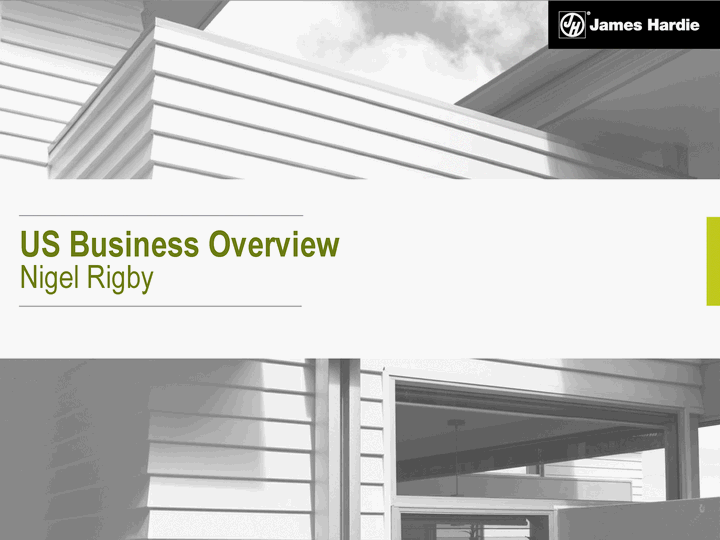

| US Business Overview Nigel Rigby |
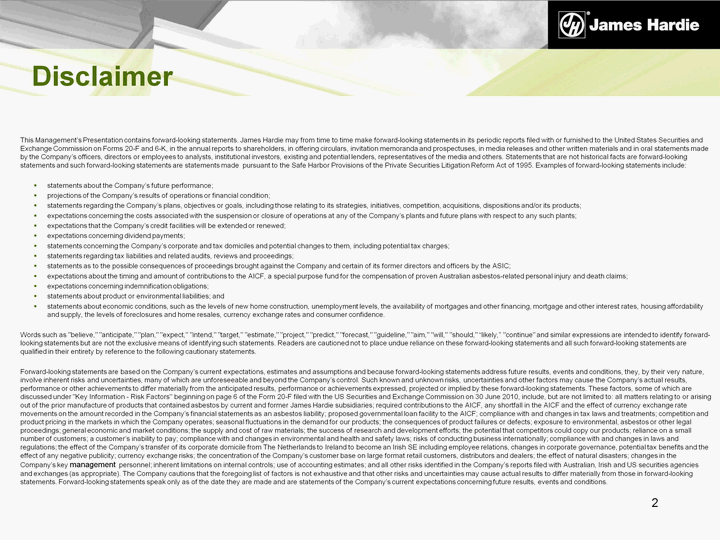
| Disclaimer This Management's Presentation contains forward-looking statements. James Hardie may from time to time make forward-looking statements in its periodic reports filed with or furnished to the United States Securities and Exchange Commission on Forms 20-F and 6-K, in the annual reports to shareholders, in offering circulars, invitation memoranda and prospectuses, in media releases and other written materials and in oral statements made by the Company's officers, directors or employees to analysts, institutional investors, existing and potential lenders, representatives of the media and others. Statements that are not historical facts are forward-looking statements and such forward-looking statements are statements made pursuant to the Safe Harbor Provisions of the Private Securities Litigation Reform Act of 1995. Examples of forward-looking statements include: statements about the Company's future performance; projections of the Company's results of operations or financial condition; statements regarding the Company's plans, objectives or goals, including those relating to its strategies, initiatives, competition, acquisitions, dispositions and/or its products; expectations concerning the costs associated with the suspension or closure of operations at any of the Company's plants and future plans with respect to any such plants; expectations that the Company's credit facilities will be extended or renewed; expectations concerning dividend payments; statements concerning the Company's corporate and tax domiciles and potential changes to them, including potential tax charges; statements regarding tax liabilities and related audits, reviews and proceedings; statements as to the possible consequences of proceedings brought against the Company and certain of its former directors and officers by the ASIC; expectations about the timing and amount of contributions to the AICF, a special purpose fund for the compensation of proven Australian asbestos-related personal injury and death claims; expectations concerning indemnification obligations; statements about product or environmental liabilities; and statements about economic conditions, such as the levels of new home construction, unemployment levels, the availability of mortgages and other financing, mortgage and other interest rates, housing affordability and supply, the levels of foreclosures and home resales, currency exchange rates and consumer confidence. Words such as "believe," "anticipate," "plan," "expect," "intend," "target," "estimate," "project," "predict," "forecast," "guideline," "aim," "will," "should," "likely," "continue" and similar expressions are intended to identify forward- looking statements but are not the exclusive means of identifying such statements. Readers are cautioned not to place undue reliance on these forward-looking statements and all such forward-looking statements are qualified in their entirety by reference to the following cautionary statements. Forward-looking statements are based on the Company's current expectations, estimates and assumptions and because forward-looking statements address future results, events and conditions, they, by their very nature, involve inherent risks and uncertainties, many of which are unforeseeable and beyond the Company's control. Such known and unknown risks, uncertainties and other factors may cause the Company's actual results, performance or other achievements to differ materially from the anticipated results, performance or achievements expressed, projected or implied by these forward-looking statements. These factors, some of which are discussed under "Key Information - Risk Factors" beginning on page 6 of the Form 20-F filed with the US Securities and Exchange Commission on 30 June 2010, include, but are not limited to: all matters relating to or arising out of the prior manufacture of products that contained asbestos by current and former James Hardie subsidiaries; required contributions to the AICF, any shortfall in the AICF and the effect of currency exchange rate movements on the amount recorded in the Company's financial statements as an asbestos liability; proposed governmental loan facility to the AICF; compliance with and changes in tax laws and treatments; competition and product pricing in the markets in which the Company operates; seasonal fluctuations in the demand for our products; the consequences of product failures or defects; exposure to environmental, asbestos or other legal proceedings; general economic and market conditions; the supply and cost of raw materials; the success of research and development efforts; the potential that competitors could copy our products; reliance on a small number of customers; a customer's inability to pay; compliance with and changes in environmental and health and safety laws; risks of conducting business internationally; compliance with and changes in laws and regulations; the effect of the Company's transfer of its corporate domicile from The Netherlands to Ireland to become an Irish SE including employee relations, changes in corporate governance, potential tax benefits and the effect of any negative publicity; currency exchange risks; the concentration of the Company's customer base on large format retail customers, distributors and dealers; the effect of natural disasters; changes in the Company's key management personnel; inherent limitations on internal controls; use of accounting estimates; and all other risks identified in the Company's reports filed with Australian, Irish and US securities agencies and exchanges (as appropriate). The Company cautions that the foregoing list of factors is not exhaustive and that other risks and uncertainties may cause actual results to differ materially from those in forward-looking statements. Forward-looking statements speak only as of the date they are made and are statements of the Company's current expectations concerning future results, events and conditions. 2 |
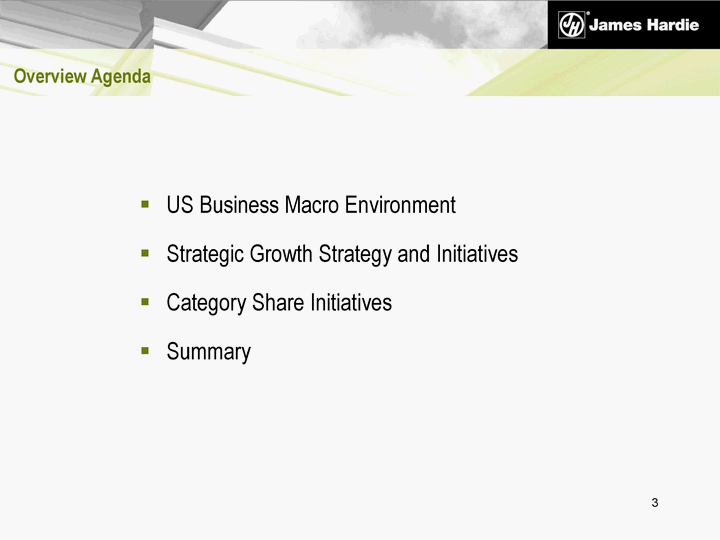
| Overview Agenda US Business Macro Environment Strategic Growth Strategy and Initiatives Category Share Initiatives Summary 3 |
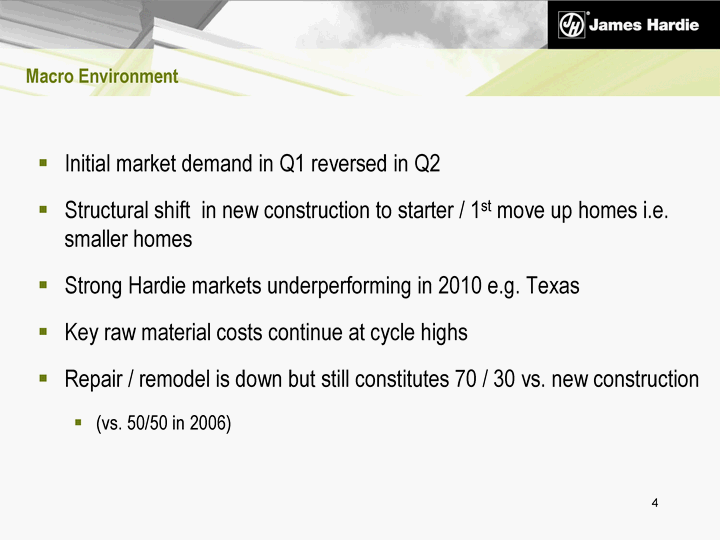
| Macro Environment Initial market demand in Q1 reversed in Q2 Structural shift in new construction to starter / 1st move up homes i.e. smaller homes Strong Hardie markets underperforming in 2010 e.g. Texas Key raw material costs continue at cycle highs Repair / remodel is down but still constitutes 70 / 30 vs. new construction (vs. 50/50 in 2006) 4 |
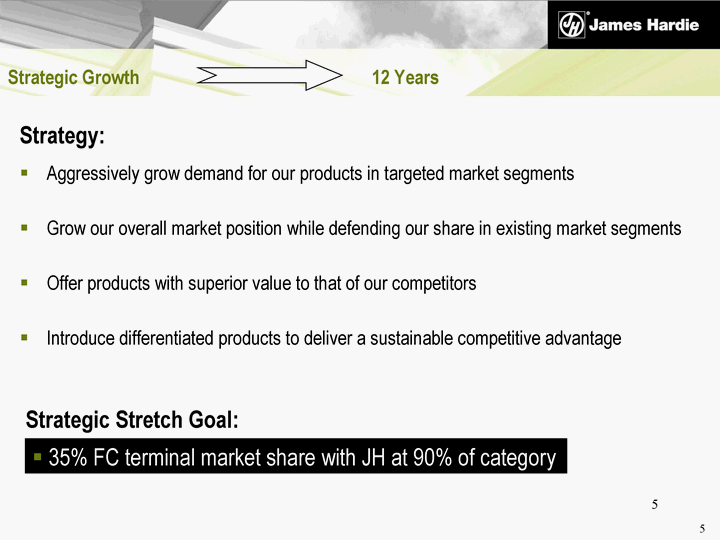
| 5 5 Strategic Growth 12 Years Strategy: Aggressively grow demand for our products in targeted market segments Grow our overall market position while defending our share in existing market segments Offer products with superior value to that of our competitors Introduce differentiated products to deliver a sustainable competitive advantage Strategic Stretch Goal: 35% FC terminal market share with JH at 90% of category |
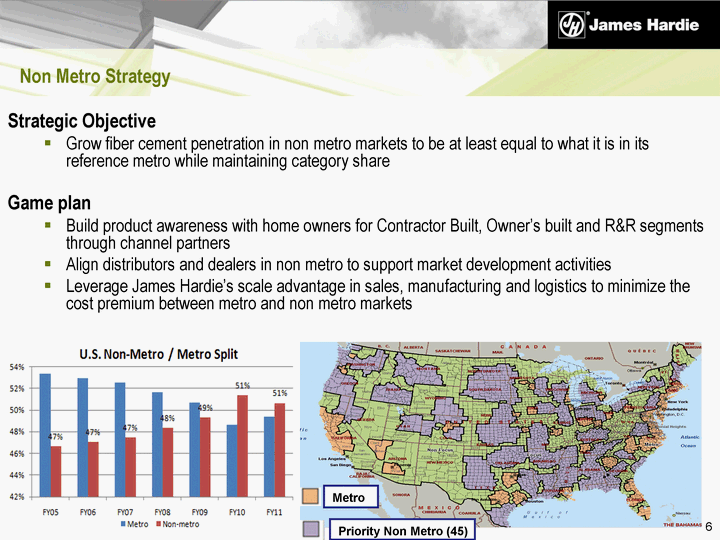
| Non Metro Strategy Strategic Objective Grow fiber cement penetration in non metro markets to be at least equal to what it is in its reference metro while maintaining category share Game plan Build product awareness with home owners for Contractor Built, Owner's built and R&R segments through channel partners Align distributors and dealers in non metro to support market development activities Leverage James Hardie's scale advantage in sales, manufacturing and logistics to minimize the cost premium between metro and non metro markets 6 Priority Non Metro (45) Metro 6 |
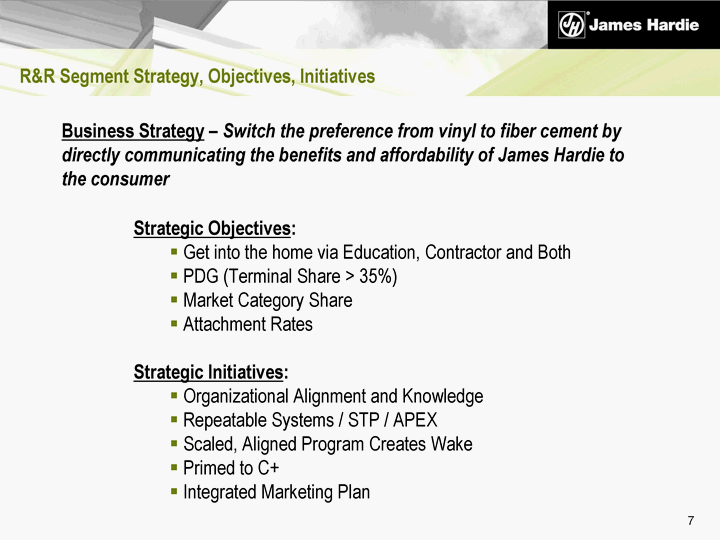
| R&R Segment Strategy, Objectives, Initiatives 7 Business Strategy - Switch the preference from vinyl to fiber cement by directly communicating the benefits and affordability of James Hardie to the consumer Strategic Objectives: Get into the home via Education, Contractor and Both PDG (Terminal Share > 35%) Market Category Share Attachment Rates Strategic Initiatives: Organizational Alignment and Knowledge Repeatable Systems / STP / APEX Scaled, Aligned Program Creates Wake Primed to C+ Integrated Marketing Plan |

| R&R Market Opportunities 8 |

| 0 1 2 3 4 5 6 7 8 9 10 11 12 13 14 15 16 17 18 19 2004 - 2010 Color focused at the North vinyl substitution model Focused channel access to scale dealers Focused Color / Product range due to inventory constraints Job / House Packs remove the supply chain barriers to ColorPlus adoption in Primed to Color markets. Enables Box Retailers and Non Metro markets in vinyl markets 9 Arrive at Dealer Manufacture Dealer Order Transfer at Distribution Distribution Order Order Entry, Scheduling Transportation DAYS Today (average) With House Packs Lead time compressed by removing channel holdups and by automating scheduling & production planning Next Evolution of Color - Color Job / House Packs |
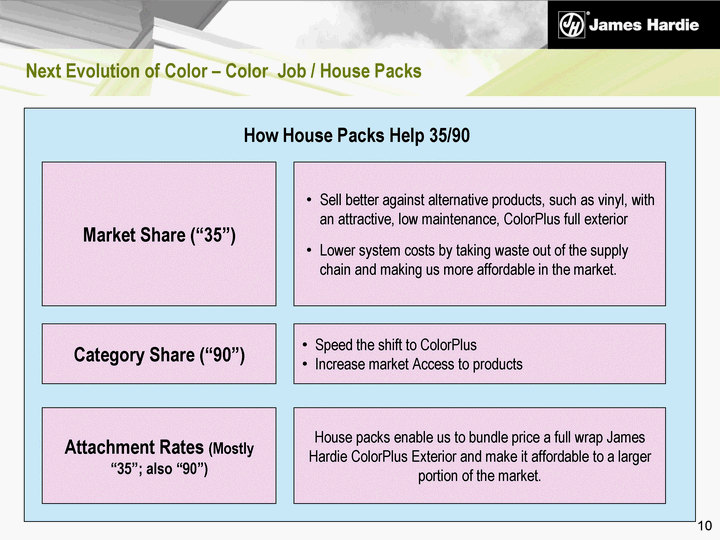
| 10 Next Evolution of Color - Color Job / House Packs Category Share ("90") Speed the shift to ColorPlus Increase market Access to products Market Share ("35") Sell better against alternative products, such as vinyl, with an attractive, low maintenance, ColorPlus full exterior Lower system costs by taking waste out of the supply chain and making us more affordable in the market. Attachment Rates (Mostly "35"; also "90") House packs enable us to bundle price a full wrap James Hardie ColorPlus Exterior and make it affordable to a larger portion of the market. How House Packs Help 35/90 10 |
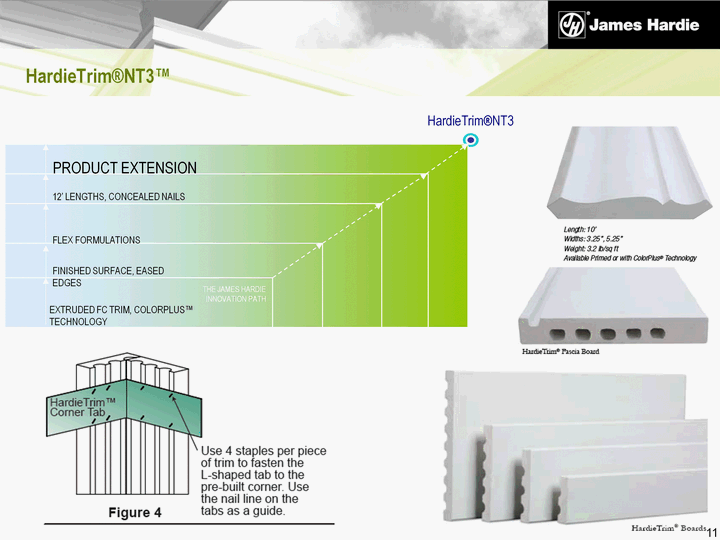
| 11 HardieTrim(r)NT3(tm) HardieTrim(r)NT3 EXTRUDED FC TRIM, COLORPLUS(tm) TECHNOLOGY FINISHED SURFACE, EASED EDGES FLEX FORMULATIONS 12' LENGTHS, CONCEALED NAILS THE JAMES HARDIE INNOVATION PATH PRODUCT EXTENSION 11 |
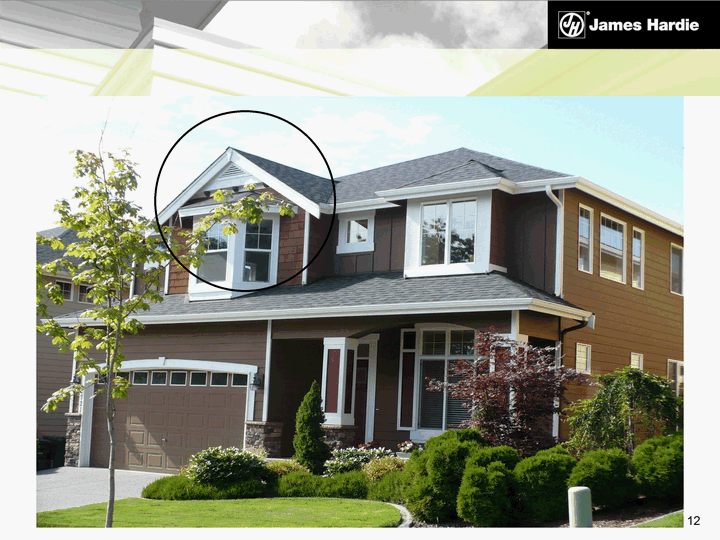
| Photo of bad shingle 12 |
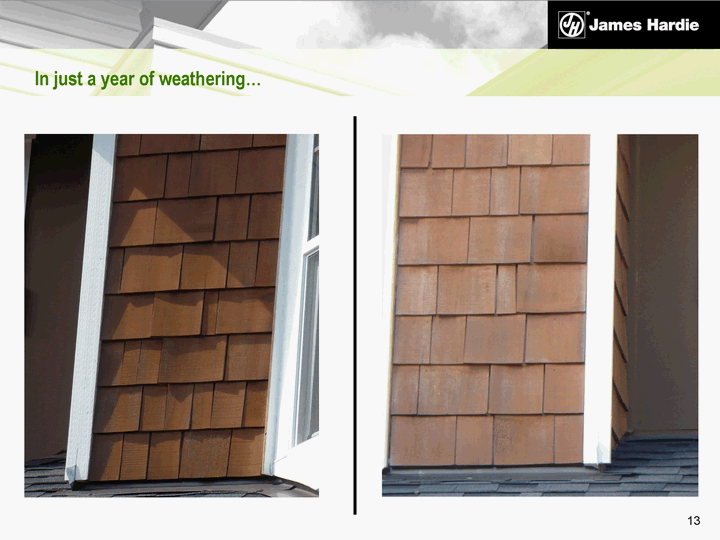
| In just a year of weathering... 13 |
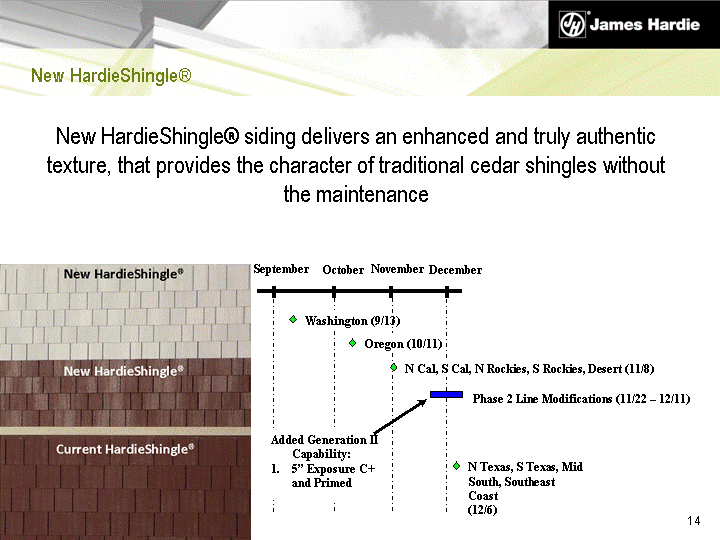
| New HardieShingle(r) September October November December Oregon (10/11) N Cal, S Cal, N Rockies, S Rockies, Desert (11/8) N Texas, S Texas, Mid South, Southeast Coast (12/6) Phase 2 Line Modifications (11/22 - 12/11) Added Generation II Capability: 5" Exposure C+ and Primed Washington (9/13) New HardieShingle(r) siding delivers an enhanced and truly authentic texture, that provides the character of traditional cedar shingles without the maintenance 14 |
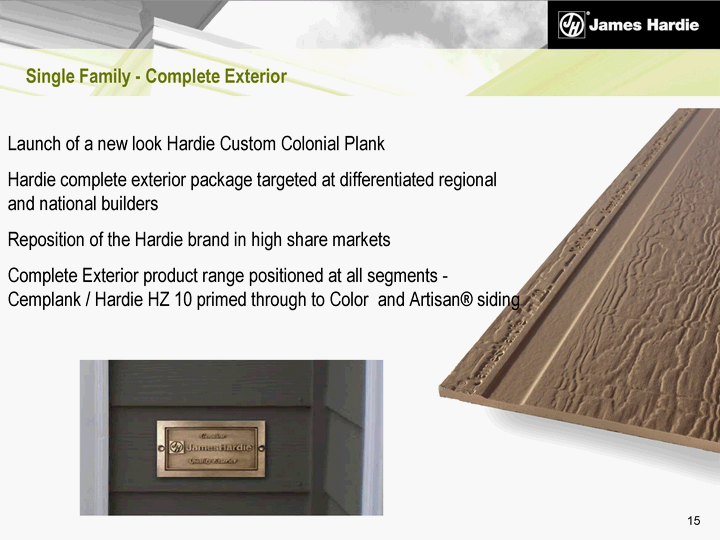
| Single Family - Complete Exterior Launch of a new look Hardie Custom Colonial Plank Hardie complete exterior package targeted at differentiated regional and national builders Reposition of the Hardie brand in high share markets Complete Exterior product range positioned at all segments - Cemplank / Hardie HZ 10 primed through to Color and Artisan(r) siding 15 |
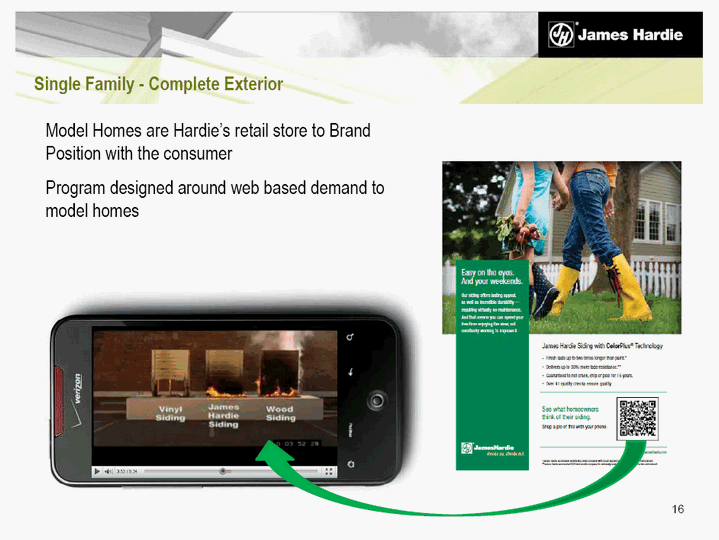
| Single Family - Complete Exterior Model Homes are Hardie's retail store to Brand Position with the consumer Program designed around web based demand to model homes 16 |
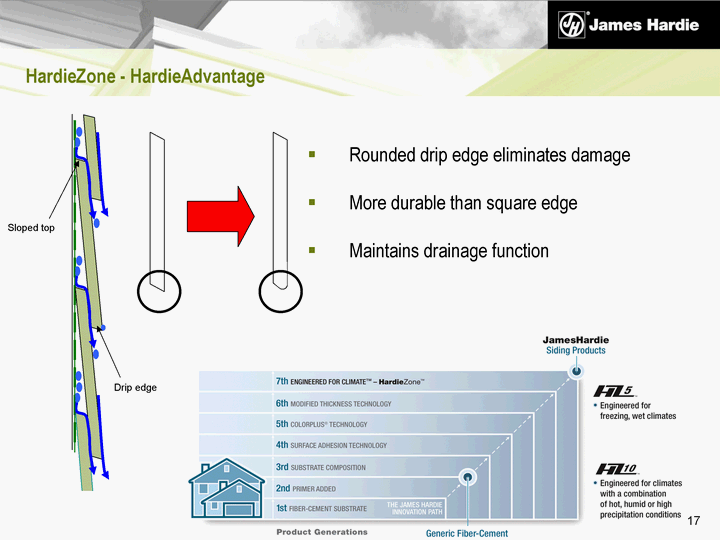
| HardieZone - HardieAdvantage Drip edge Sloped top Rounded drip edge eliminates damage More durable than square edge Maintains drainage function 17 |
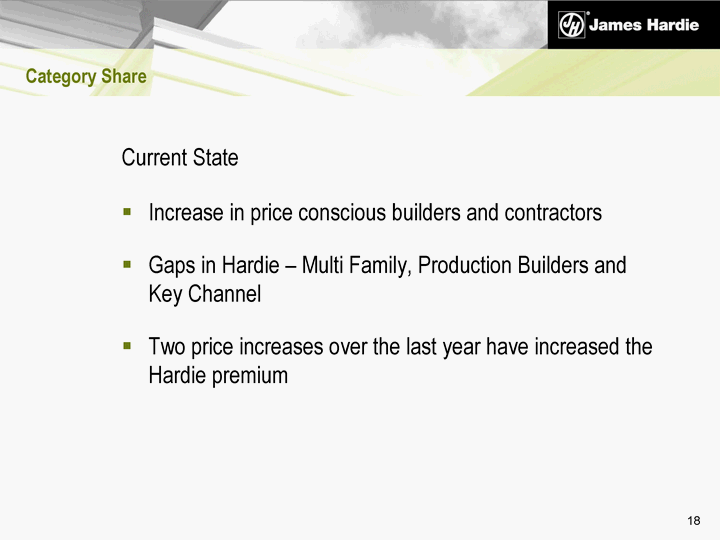
| Category Share Current State Increase in price conscious builders and contractors Gaps in Hardie - Multi Family, Production Builders and Key Channel Two price increases over the last year have increased the Hardie premium 18 |
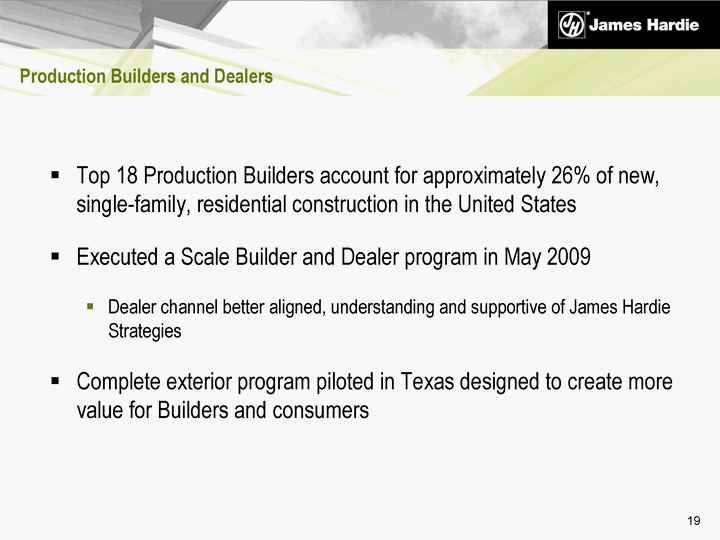
| Production Builders and Dealers Top 18 Production Builders account for approximately 26% of new, single-family, residential construction in the United States Executed a Scale Builder and Dealer program in May 2009 Dealer channel better aligned, understanding and supportive of James Hardie Strategies Complete exterior program piloted in Texas designed to create more value for Builders and consumers 19 |

| Retail Committed to Programs with both Home Depot and Lowe's across exteriors and interiors Hardiebacker is now 50%+ of retail cement backer board market Opportunity in R&R segment around our Color house pack program 20 |
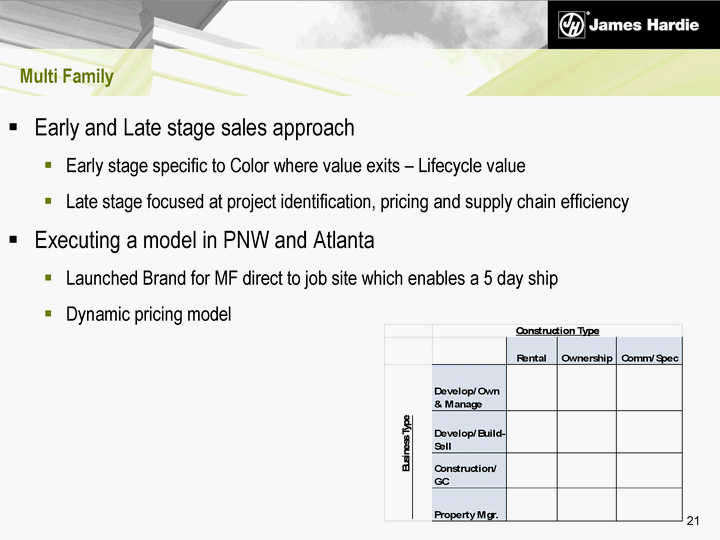
| Multi Family Early and Late stage sales approach Early stage specific to Color where value exits - Lifecycle value Late stage focused at project identification, pricing and supply chain efficiency Executing a model in PNW and Atlanta Launched Brand for MF direct to job site which enables a 5 day ship Dynamic pricing model 21 |
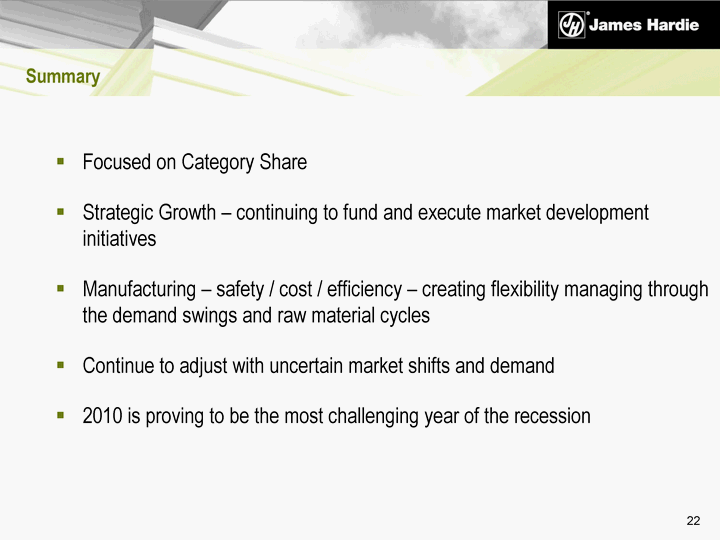
| Summary Focused on Category Share Strategic Growth - continuing to fund and execute market development initiatives Manufacturing - safety / cost / efficiency - creating flexibility managing through the demand swings and raw material cycles Continue to adjust with uncertain market shifts and demand 2010 is proving to be the most challenging year of the recession 22 |

| Questions 23 |